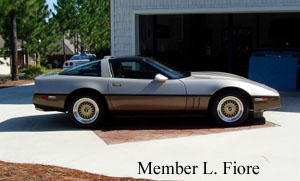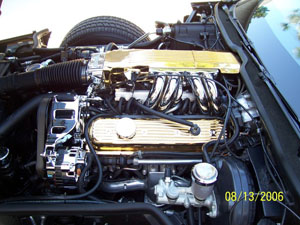As printed in For Vettes Only in October 1985.
 There’s good news and bad news. The good news is that sometime around January 1986 Vette lovers with bucks to spare will be able to mosey down to the local Chevrolet store and buy a brand new Corvette convertible. The bad news is that as this is being written no additional information on the little glass drop top has been released. Keep an eye on FVO for facts as they appear. In the meantime, let’s take a look at the latest edition of the Sport Coupe (model 1YY07)
There’s good news and bad news. The good news is that sometime around January 1986 Vette lovers with bucks to spare will be able to mosey down to the local Chevrolet store and buy a brand new Corvette convertible. The bad news is that as this is being written no additional information on the little glass drop top has been released. Keep an eye on FVO for facts as they appear. In the meantime, let’s take a look at the latest edition of the Sport Coupe (model 1YY07)Chevrolet had this modest comment on the 1986 Corvette. “The engineers couldn’t leave well enough alone. So Corvette is a far different animal in 1986 from the 1985 edition. It’s easier to spot (bright yellow is a new color. So is a brilliant white/silver metallic two-tone combo). It’s also harder to steal, easier to stop, lighter, quicker and more fuel efficient.”
You’d think these guys were trying to sell you something.
The same 5.7-liter V8 that’s powered every Corvette since 1981 returns for 1986.
But the introduction of aluminum cylinder heads on Chevrolet’s 1986 Corvette will be delayed while the heads are redesigned to eliminate a cracking condition around the head attachment bosses. As a result, early-production ’86 Corvettes will be equipped with cast iron heads. Castings in the water jacket area of the aluminum heads had been thinned intentionally to reduce mass and improve cooling. Durability tests revealed the thinning weakened the structure enough to allow the bosses to crack under high stress. Design of the heads has been revised to alleviate the problem, and they will be placed in production as soon as testing confirms their integrity.
New for ’86 are centrally located copper core spark plugs, larger inlet ports and sintered metal valve seats. The combination of less mass, less friction (5W30) oil is recommended) and more efficient combustion makes possible a powertrain package that satisfies emissions and fuel economy requirements with little of no sacrifice in performance.
The copper core provides improved heat dissipation to cool the electrode, and thus, prevent preignition tendencies. The ceramic tip insulator heats fast to help burn off deposit build-up, and thus, prevent plug fouling. Heat is dissipated from the plug electrode, through the ceramic tip insulator, and through the plug seat to the cylinder block water jacket. Also, the electrode gap is decreased from 0.045 inch (1.14mm) to 0.035 inch (0.9mm) to reduce the voltage required to fire the plugs, and thus, reduce the requirement of the ignition system.
The Corvette high performance V8 with Tuned Port Fuel Injection (TPI) features significant improvements for 1986.
The overall engine is lighter in weight, features increased volumetric efficiency, improvement in the combustion process, and has a higher compression ratio to more efficiently convert head energy into mechanical energy.
The Corvette cylinder heads are made from aluminum alloy castings and each head weighs 12.5 pounds (9.75 kg) less than the 1985 cast iron heads.
In addition to the more rapid heat transfer of aluminum, cylinder head cooling is improved through use of larger coolant passages along the exhaust manifold mounting face and by adding a water crossover passage in place of the exhaust heat passage. The exhaust crossover was eliminated to remove this heat source from the center of the heads, and was possible because induction system heat is not required with the sophisticated TPA system. Also, an outlet was added to the rear of the head to allow coolant flow through this previous blocked passage to prevent the possibility of having air trapped in this section of the head.
Both the four-speed overdrive automatic and the 4-plus-3 manual are still available, but a new upshift indicator light on the instrument cluster has been added to increase gas mileage in all types of driving. A new dual exhaust system depends on three monolith catalytic converters to maximize emissions control during engine warm-up.
Outside, a center-mounted stoplight appears atop the hatch hinge and the cast alloy wheels get a new raised hub emblem and a highly polished brushed aluminum appearance. Standard tires are P245/VR50-16s with P255s mandatory on the Z51 package.
Inside, the instrument cluster is canted to reduce glare, and last year’s sport seat cloth is now standard and this year’s sport seat is leather. Optional electronic air conditioning will be introduced-ironically-at around the same time as the convertible.
The 1986 Corvette is the first General Motors vehicle of any kind to employ a new electronic anti-theft system, know as VATS (Vehicle Anti-Theft System), that can delay a potential thief’s effort by as much as a half an hour when only 10 minutes is considered plenty to deter most thieves. With VATS as standard equipment, the would be thief would be faced with the prospect, after breaking into the car, of plugging as many as 15 resistors into a circuit until he finds the right one. The average break-in time by trial and error has turned out to be between 15 and 20 minutes.
And then there are the brakes: based primarily on the Bosch ABS II design, Corvette’s new standard computerized anti-lock system automatically controls wheel lock-up during hard braking and allows the driver to retain steering control. Any tendency for the car to spin is reduced and can be easily countered by steering correction. Sophisticated electronics are utilized to detect when any wheel is on the verge of locking up. It then controls braking action to make maximum use of available traction. A noticeable pulsing through the brake pedal tells the pilot the control process is in effect.
As the advertising boys are so fond of saying, there’s more, but we’ve covered the big stuff. The place to see the rest is on the car at the Chevy store. And when we hear more about that new convertible we’ll let you know.
|
’86 VETTE FACTS
|
|
|
VEHICLE IDENTIFICATION NUMBER
|
1986 the numbers were Coupe 1G1YY078[ ]G5100001 to 1G1YY078[ ]G5127794; Conv. 1G1YY678[ ]G5900001 to 1G1YY678[ ] G5907315. The first symbol 1 indicated US built. The second symbol identified General Motors product. The third symbol 1 indicates Chevrolet Motor Division vehicle. The fourth and fifth symbols indicated car and line series: (YY=Corvette). The sixth and seventh symbols indicate the body style number (07=two-door hatchback coupe; 67=convertible). The eighth symbol indicates engine: 8=5.7 Tuned Port Injection (TPI) Chevrolet V-8. The ninth symbol [ ] is a check digit that varies. The tenth symbol indicates model year (G=1986). The eleventh symbol indicates the assembly plant: (5=Bowling Green). The las six symbols indicate the sequential production number starting with 100001 for coupes; 900001 for convertibles.
|
|
ENGINE
|
BASE ENGINE
Type: V-8 90-degree overhead valve
Cast iron block and head
Bore and stroke: 4.00 x 3.48 in.
Displacement: 350 cid
Brake hp: 230at 4000 rpm.
Induction: Tuned-Port Injection system
Type: V-8 90-degree overhead valve
Aluminum cylinder heads
Bore and stroke: 4.00 x 3.48 in.
Displacement: 350 cid
Brake hp: 235at 4000 rpm
Induction: Tuned-Port Injection system
|
|
VITAL STATS
|
Coupe
Original Price: $27,027.00
Production: 27,794
Wheelbase: 96.2 in.
Length: 176.5 in.
Tires: P245/50VR-16 or P255/50VR-16 SBR
Convertible
Original Price: $32,032.00
Production: 7,315
Wheelbase: 96.2 in.
Length: 176.5 in.
Tires: P245/50VR-16 or P255/50VR-16 SBR
|
|
COOL STUFF
|
• First built Corvette convertible since 1975 model.
• 1986 Convertible was the pace car for the 1986 Indianapolis 500.
All convertibles sold were designated as pace cars replicas regardless of color or option content, and all included decal pakcages for dealer or customer installation.
• Fifty "Malcom Konner Commemorative Edition" Corvettes were built in a special arrangement honoring the NJ Chevrolet dealership's founder. RPO4001ZA and added $500 to the cost.
|